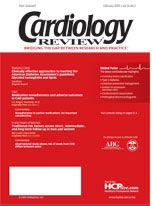Publication
Article
ASH proposes new definition of hypertension
Hypertension
San Francisco—A new definition of hypertension that incorporates additional risk factors for cardiovascular disease has been proposed by a writing group for the American Society of Hypertension (ASH). The proposal was announced at the 20th Annual Scientific Meeting of ASH in San Francisco.
Defining hypertension solely by numbers “doesn’t suffice because blood pressure is a continuous variable,” said Thomas Giles, MD, president of ASH and professor of medicine at Louisiana State University, New Orleans.
“In the past, there was a heavy reliance on blood pressure numbers…
limiting the ability to calculate risk in an individual. Hypertension is more than just an elevated number,” he said.
“Our new definition incorporates the presence or absence of risk factors, early disease markers, and target-organ damage, and more accurately represents the different physiological abnormalities in the cardiovascular system and other organs caused by hypertension.”
The new definition is needed, he said, because more than 80% of patients with hypertension have additional comorbidities, such as obesity or glucose or lipid abnormalities. “For any level of blood pressure, the risk adjustment depends on a huge number of factors that need treatment as well,” he said.
Current blood pressure classifications use arbitrary cutpoints to define hypertension at its various stages, without assessing the patient’s actual risk based on other factors such as left ventricular hypertrophy, microalbuminuria, or lipid levels. This system may be misleading because an individual patient’s blood pressure can fall a few millimeters of mercury below a defining cutpoint yet the patient can have a significant number of other cardiovascular risk factors or target-organ damage.
The proposed new definition is as
follows:
“Hypertension is a progressive car-diovascular syndrome arising from complex and interrelated etiologies. Early markers of the syndrome are often
present before blood pressure elevation is sustained; therefore, hypertension
cannot be classified solely by discrete blood pressure thresholds. Progression
is strongly associated with functional
and structural cardiac and vascular abnormalities that damage the heart,
kidneys, brain, vasculature and other organs and lead to premature morbidity and death.”
An expanded classification scheme has also been proposed to reflect the new thinking. For example, Stage 1 hypertension would be defined by early signs of functional and structural changes in the heart and small arteries, “and could be reflected in, for example, microalbuminuria, just to indicate one,” he said. This stage would also include individuals with multiple cardiovascular risk factors and early disease who do not yet show evidence of target-organ damage.
The new definition does not contain the “prehypertension” category that was created by the seventh report of the Joint National Committee on Prevention, Detection, Evaluation, and Treatment of
High Blood Pressure (JNC 7). “We believed that the term was a transitional one,” said Dr. Giles. “It painted 40 million people with the same brush but within this group there are some at low risk and some at high risk.” Under the proposed new definition, individuals with low blood pressure levels and no signs of vascular abnormalities are classified simply as normal, thus averting any stigma.
The goal of the new definition is to assist practitioners in identifying individuals at risk for cardiovascular disease at an earlier point in the disease process, he continued. This may mean a risk assessment strategy that incorporates an electrocardiographic measure of left ventricular size, screening for microalbuminuria, a lipid profile, a measure of glucose metabolism, and potentially a determination of systemic inflammation and plasma renin levels.
In the new definition, treatment of hypertension may change to include HMG-CoA reductase inhibitors (statins) and thiazolidinediones. “We’ll need a thinking physician and a thinking patient to come up with the best regimen for every individual,” said Dr. Giles.
Said Michael Weber, MD, professor
of medicine, State University of New York in Brooklyn, “clinical heterogeneity is really a major key for understanding hy-pertension and having to consider a new definition.”
